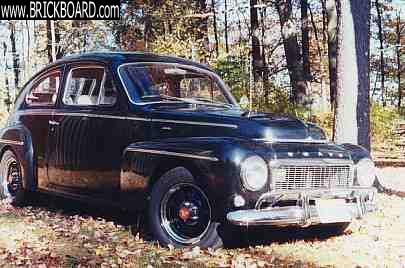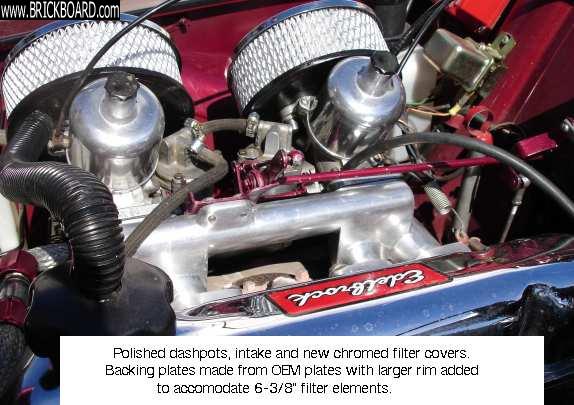
|
|
I just received a message from Alberto Averill, aaverillcl@hotmail.com, President of the Chilean Volvo Club, in which he states that he has located a fiberglass molder in Chile who does bodies for replicars and who quoted him a price of US$316 to make a mold of a PV544 front clip, and US$158, i.e., 100K Chilean Pesos, for each "knock-off" made therein. That is a one-piece tub comprising fenders, hood, and frontal section. If the quality is any good, even if you double, or even tripple, that price to include shipping, it would still be a pretty good deal. The Chileans are apparently working on a project to resurrect PVs for racing. Albert does fine with English, so if you are interested, contact him.
Bob S.
|
|
-

|
|
http://www.georger.com/544_volvo_front_end.htm
I have one that I made last year. It is a wonderful Idea and I am proud I did it. Take a look. If you're interested I'm in Buffalo NY.
Christopher Virgilthevolvo Georger

|
|
-

|
|
Christopher, I've been following your periodic postings about the fiberglass nosepiece for Virgil with interest -- albeit theoretical for the moment, since the front clip on my PV is still exceptionally solid. As a bit of a boat builder, the idea appealed to me, but what really caught my attention with the Chilean project was the prices they were talking about. What do you figure you would have to charge if you were to go into semi-commercial production, like, let's say, two or three units a year? BTW, the piece in the picture looks really good! Did you lay it up over gelcoat in a female mold, or was it made over a male mold and filled and painted? I'm assuming that the Chileans would be using a female mold, gelcoat, and a chopper gun. Hand lay-up seems not feasible at those prices.
Bob S.
|
|
-

|
|
Sil,
This is a one piece nose from a female mold of 9 individual pieces. The compound curves and accurate lines at the lower fender lip made it very difficult to make the mold in fewer pieces. I have a seam (mold junction)down the hood center and across the top center of each fender. Then there's a seam from headlight to headlight, across the back and inside the lower lip. I have access to a chpooer gun but my experience was a very heavy final product. My 544 nose weighs around 48 lbs and I even slammed into a snow bank in January without even a crack. It is hand laid up and consists of a first layer of mat followed by some strategic woven cloth and then 2 layers more of mat. It could be done in one less layer but I like what I have and if I make another I would still make it the same way as the first.
As for production, my first piece wen onto Virgil and he's a frankenstein. Fitment was envolved and tedious and attachment to a non-original body really cannot be used as a good examle. The mold was created from steel fenders and hood and grill support. But they were unrelated. I need to attach to an original 544 and see how it works before I can say it's a "good fit". Nothing forward of the firewall on Virgil is original. Attachment has issues because all the steering rods are in front of the wheels and virtually the most forward pieces on the car. Tipping or Tilting when the original body work goes "under" these pieces makes for a problem. I used a file cabinet slide to "slide" towards the front 6 inches before tilting and I really neded 10"- 12" to clear the rear indents and also the steering before the tilt. Plus there's the radiator that, without the support, needs to connect to something and inner fender wells should stay on the car when you lift off the nose.
How much? If you're a boat builder you will relate to the work environment of fiberglass. It is toxic, messy, clean up takes days, and the mold is as big as the piece. It cannot be done in a home or even an attached garage. It will take 2 weeks to lay it up and another week to be sure all the "bubbles" are out. Bubbles occur when heat comes and goes in fiberglass. It comes if it kicks off before you get to roll it out (big pieces) and comes back if the bubble expands by introducing solar heat. In a boat your gel coat is usually kept cool in the water or at least facing down. For a car, the sun will bake it and any "voids" of either air or un-cured resin will expand and produce an irregular blister that will disappear in a cool environment (like when you're trying to find it back home in the garage).
So, making 2-4 per year is possible but I'd want too much and even then freight, attachment, paint, and blisters are add-ons. Freight has to be the big one here. These cannot be "nested" and they are huge as far as freight handlers are concerned. At this point I don't know how the Chile workers can produce what you have described for the amount you have listed. Plus they probably will have the same learning issues I had resulting in the same less than perfect nose. the other thing is a shear lack of demand. I drive my car and I might bump into things and need a new fender because I drive my car in the snow and ice. Most 544's are sitting in a garage and taken out on sunny days. If a 544 has lasted all these years, chances are that it doesn't need fenders much less a one piece nose. As for racing... most sanctioning groups prohibit certain non-original materials ... go figure. I'll probably make another when someone really wants one.
Christopher

|
|
-

|
|
Thanks for the detailed reply. I should have gone to your web-site BEFORE I responded to your message, and I would have found most of the answers to my questions. What you say about fiberglass behavior makes perfect sense to me, and your observations about attachment and clearances are extremely valuable, particularly since they are based on experience. I will refer Alberto to your post and web-site. I'm sure he'll find them extremely interesting.
Bob S.
|
|
-

|
|
Duplicate message deleted
|
|
-

|
|
Sounds like a good deal... Some time ago, I had thought of doing a minor hot rod job on a freinds scrapped out 444... I was thinking a single piece tilt forward front end would make a small block V8 conversion easy... too bad he already got rid of the car. I got plenty of other projects anyhow.
-Matt
--
-Matt '70 145s, '65 1800s, '66 122s wagon, others inc. '53 XK120 FHC
|
|
-

|
|
Let's not forget that bolting or riveting the hood and fenders together in one piece is pretty easy, and mounting the one-piece front end on an original car is pretty simple. We did this for several PV544 race cars we had back in the late 60's.
In fact, just a wekk or two ago I found one of theos old front clips at my Dad's place. Big bubble on the right side to allow for a big one-pice air filter he had mounted on a pair of Weber carbs.
Except that it's dinged and dented from a lot of turns around the track, I'd consider using it if I had to. For someone wanting to build a race car it's exactly what you need - cosmetics taking a back seat to utility!
Did I ever mention the time we had such high compression (about 14:1) in an engine that we blew the center ceramic element of a spark plug right out THROUGH the hood? Those were awesome engines we built; used VW oversized valves, etc. Everything ported, polished, and balanced. Turned well above 10K RPM. ZOOOOM!
|
|
|
|
|




